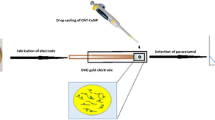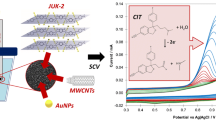Abstract
An electrochemical sensor for the determination of artemisinin has been developed based on a glassy carbon electrode modified with hybrid nanocomposites of cobalt phthalocyanine, graphene nanoplatelets, multi-walled carbon nanotubes and ionic liquids (IL). To improve the sensitivity and selectivity of the sensor, cobalt phthalocyanine (CoPc) was used as an effective redox mediator to promote and catalyze the artemisinin reduction. Furthermore, the graphene nanoplatelets and multi-walled carbon nanotubes were used as excellent conducting supporting materials to improve the sensitivity of the electrochemical sensor. Moreover, IL with a surface charge was also employed to prevent aggregation of the graphene nanoplatelets and multi-walled carbon nanotubes. The analytical signal was generated from the reduction of Co(III)Pc generated by artemisinin. The proposed electrochemical sensor was applied to the detection of artemisinin using differential pulse voltammetry and provided a signal with wide linearity ranging from 1.5–60 μM and 60–600 μM and a detection limit of 0.70 μM (3SD/m). Furthermore, the proposed sensor displayed good repeatability and reproducibility of 2.9–3.0 and 3.1–4.4% RSD, respectively. Applications of the sensor to drug and plant samples demonstrated accuracy in a range of 105–116% recoveries. In addition, the results were in good agreement with those obtained from the HPLC method as a reference technique. Thus, the proposed electrochemical sensor provides a new alternative platform for sensitive and selective determination of artemisinin in the analysis of pharmaceuticals with good precision and accuracy.
Graphical abstract






Similar content being viewed by others
References
World malaria report 2020: 20 years of global progress and challenges (2020). Geneva, Switzerland: World Health organization; 2020. Licence: CC BY-NC-SA 3.0 IGO. https://www.who.int/publications/i/item/9789240015791. Accessed 1 June 2021
Rosenthal PJ (2001) Antimalarial chemotherapy: mechanisms of action, resistance, and new directions in drug discovery, 1st edn. Springer Science & Business Media, New Jersey, pp 3–12
Bharati A, Sabat S (2010) A spectrophotometric assay for quantification of artemisinin. Talanta 82(3):1033–1037
Ivanescu B, Vlase L, Corciova A, Lazar MI (2011) Artemisinin evaluation in Romanian Artemisia annua wild plants using a new HPLC/MS method. Nat Prod Res 25(7):716–722
Jessing KK, Juhler RK, Strobel BW (2011) Monitoring of Artemisinin, Dihydroartemisinin, and Artemether in environmental matrices using high-performance liquid chromatography–tandem mass spectrometry (LC-MS/MS). J Agric Food Chem 59(21):11735–11743
Bai H, Wang C, Chen J, Peng J, Cao Q (2015) A novel sensitive electrochemical sensor based on in-situ polymerized molecularly imprinted membranes at graphene modified electrode for artemisinin determination. Biosens Bioelectron 64:352–358
Wang C, Zholudov YT, Nsabimana A, Xu G, Li J (2016) Sensitive and selective electrochemical detection of artemisinin based on its reaction with p-aminophenylboronic acid. Anal Chim Acta 937:39–42
Nate Z, Gill AA, Chauhan R, Karpoormath R (2021) Polyaniline-cobalt oxide nanofibers for simultaneous electrochemical determination of antimalarial drugs: Primaquine and proguanil. Microchem J 160:105709
Waffo A, Yesildag C, Caserta G, Katz S, Zebger I, Lensen M, Wollenberger U, Scheller F, Altintas Z (2018) Fully electrochemical MIP sensor for artemisinin. Sens Actuators B Chem 275:163–173
Habibi B, Pournaghi-Azar MH (2010) Simultaneous determination of ascorbic acid, dopamine and uric acid by use of a MWCNT modified carbon-ceramic electrode and differential pulse voltammetry. Electrochim Acta 55(19):5492–5498
Lawal AT (2018) Progress in utilisation of graphene for electrochemical biosensors. Biosens Bioelectron 106:149–178
Song Y, Luo Y, Zhu C, Li H, Du D, Lin Y (2016) Recent advances in electrochemical biosensors based on graphene two-dimensional nanomaterials. Biosens Bioelectron 76:195–212
Bagotia N, Choudhary V, Sharma D (2019) Synergistic effect of graphene/multiwalled carbon nanotube hybrid fillers on mechanical, electrical and EMI shielding properties of polycarbonate/ethylene methyl acrylate nanocomposites. Compos B Eng 159:378–388
Toçoğlu U, Alaf M, Akbulut H (2020) Towards high cycle stability yolk-shell structured silicon/rGO/MWCNT hybrid composites for Li-ion battery negative electrodes. Mater Chem Phys 240:122160
Aragão JS, Ribeiro FW, Portela RR, Santos VN, Sousa CP, Becker H, Correia AN, de Lima-Neto P (2017) Electrochemical determination diethylstilbestrol by a multi-walled carbon nanotube/cobalt phthalocyanine film electrode. Sens Actuators B Chem 239:933–942
Nantaphol S, Jesadabundit W, Chailapakul O, Siangproh W (2019) A new electrochemical paper platform for detection of 8-hydroxyquinoline in cosmetics using a cobalt phthalocyanine-modified screen-printed carbon electrode. J Electroanal Chem 832:480–485
Beitollahi H, Nekooei S, Torkzadeh-Mahani M (2018) Amperometric immunosensor for prolactin hormone measurement using antibodies loaded on a nano-Au monolayer modified ionic liquid carbon paste electrode. Talanta 188:701–707
Li J, Lee E-C (2017) Functionalized multi-wall carbon nanotubes as an efficient additive for electrochemical DNA sensor. Sens Actuators B Chem 239:652–659
Mao A, Li H, Yu L, Hu X (2017) Electrochemical sensor based on multi-walled carbon nanotubes and chitosan-nickel complex for sensitive determination of metronidazole. J Electroanal Chem 799:257–262
Yang J-H, Gao Y, Zhang W, Tang P, Tan J, Lu A-H, Ma D (2013) Cobalt phthalocyanine–graphene oxide nanocomposite: Complicated mutual electronic interaction. J Phys Chem C 117(8):3785–3788
Jasinski R (1964) A new fuel cell cathode catalyst. Nature 201(4925):1212–1213
Hebié S, Bayo-Bangoura M, Bayo K, Servat K, Morais C, Napporn TW, Kokoh KB (2016) Electrocatalytic activity of carbon-supported metallophthalocyanine catalysts toward oxygen reduction reaction in alkaline solution. J Solid State Electrochem 20(4):931–942
Zhu X, Lu L, Duan X, Zhang K, Xu J, Hu D, Sun H, Dong L, Gao Y, Wu Y (2014) Efficient synthesis of graphene–multiwalled carbon nanotubes nanocomposite and its application in electrochemical sensing of diethylstilbestrol. J Electroanal Chem 731:84–92
Drew MG, Metcalfe J, Dascombe MJ, Ismail FM (2006) Reactions of artemisinin and arteether with acid: implications for stability and mode of antimalarial action. J Med Chem 49(20):6065–6073
Caro CA, Bedioui F, Zagal JH (2002) Electrocatalytic oxidation of nitrite on a vitreous carbon electrode modified with cobalt phthalocyanine. Electrochim Acta 47(9):1489–1494
Chiwunze TE, Palakollu VN, Gill AA, Kayamba F, Thapliyal NB, Karpoormath R (2019) A highly dispersed multi-walled carbon nanotubes and poly (methyl orange) based electrochemical sensor for the determination of an anti-malarial drug: Amodiaquine. Mater Sci Eng C 97:285–292
Gong F-C, Xiao Z-D, Cao Z, Wu D-X (2007) A selective artemisinin-sensor using metalloporphyrin as a recognition element entrapped in the Au-nanoparticles-chitosan modified electrodes. Talanta 72(4):1453–1457
Phukon P, Radhapyari K, Konwar BK, Khan R (2014) Natural polyhydroxyalkanoate–gold nanocomposite based biosensor for detection of antimalarial drug artemisinin. Mater Sci Eng C 37:314–320
Reys JRM, Lima PR, Cioletti AG, Ribeiro AS, de Abreu FC, Goulart MO, Kubota LT (2008) An amperometric sensor based on hemin adsorbed on silica gel modified with titanium oxide for electrocatalytic reduction and quantification of artemisinin. Talanta 77(2):909–914
Yang X, Gan T, Zheng X, Zhu D, Wu K (2008) Electrochemical determination of artemisinin using a multi-wall carbon nanotube film-modified electrode. Bull Korean Chem Soc 29(7):1386–1390
Debnath C, Saha P, Ortner A (2009) Electrocatalytic and analytical response of cobalt phthalocyanine modified carbon paste electrodes towards antimalarial endoperoxide artemisinin. Electroanalysis 21(3–5):657–661
Funding
This work was supported by Science Achievement Scholarship of Thailand (SAST) from the Department of Chemistry, Faculty of Science, Ubon Ratchathani University (Thailand). Center of Excellence for Innovation in Chemistry (PERCH-CIC) and Office of the Higher Education Commission, Ministry of Education (OHEC) are also appreciative acknowledged. In particular, A.S. and K.K. would like to thank ASEAN-European Academic University Network (ASEA-UNINET), the Austrian Federal Ministry of Education, Science and Research and the Austrian Agency for International Mobility and Cooperation in Education, Science and Research (OeAD-GmbH).
Author information
Authors and Affiliations
Corresponding author
Ethics declarations
Conflict of interest
The authors declare no conflict of interest.
Supplementary information.
Additional information
Publisher's note
Springer Nature remains neutral with regard to jurisdictional claims in published maps and institutional affiliations.
Supplementary Information
Below is the link to the electronic supplementary material.
Rights and permissions
About this article
Cite this article
Damphathik, C., Butmee, P., Kunpatee, K. et al. An electrochemical sensor for the voltammetric determination of artemisinin based on carbon materials and cobalt phthalocyanine. Microchim Acta 189, 224 (2022). https://doi.org/10.1007/s00604-022-05257-x
Received:
Accepted:
Published:
DOI: https://doi.org/10.1007/s00604-022-05257-x




